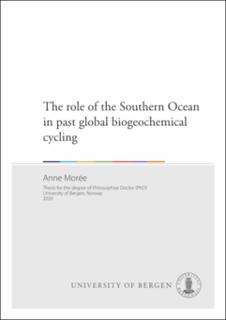| dc.contributor.author | Morée, Anne | |
| dc.date.accessioned | 2020-04-15T10:39:31Z | |
| dc.date.available | 2020-04-15T10:39:31Z | |
| dc.date.issued | 2020-04-27 | |
| dc.date.submitted | 2020-04-15T00:16:04Z | |
| dc.identifier | container/6e/30/34/4d/6e30344d-5d0a-48bd-9db9-566a37d509e9 | |
| dc.identifier.uri | https://hdl.handle.net/1956/21864 | |
| dc.description.abstract | This thesis describes several recent advances on the role of the Southern Ocean in past global biogeochemical cycling. We focus on the ocean of the Last Glacial Maximum (LGM) and the Pleistocene epoch and apply proxies of long-term climate variability (particularly the deep-sea sediment records of δ\(^{13}\)C and δ\(^{18}\)O). Specifically, we aim to explore how the physical and biogeochemical state of the Southern Ocean influenced past global marine tracer distributions, such that we can better interpret proxy data and improve our understanding of the drivers of long-term climate variability. The focus on the ocean realm is motivated by the large carbon reservoir in the (deep) ocean, which is able to interact with the atmosphere and govern atmospheric pCO\(_2\) on millennial timescales – particularly through Southern Ocean processes. The LGM and Pleistocene represent the most recent glacial extreme and glacial-interglacial cycles, respectively. Therefore, relatively many proxy data are available, and their recorded climate variability is likely indicative of long-term natural climate variability. We applied global ocean models of different complexities (NorESM-OC, HAMOCC2s and TMI) to study the drivers that shape the benthic δ\(^{13}\)C and δ\(^{18}\)O records. Applying these, we studied the role of the Southern Ocean in shaping vertical marine δ\(^{13}\)C gradients (Paper I), as well as its contribution to the δ\(^{18}\)O archive of glacial-interglacial cycles (Paper IV) using idealized model experiments. Besides these, the LGM ocean and its circulation and biological changes are studied to reveal and explore their relative importance in a more complex model setup (NorESM-OC; Papers II and III). A central conclusion of this thesis is that knowledge of the relevant water mass end-member characteristics is fundamental for interpretation of the benthic δ\(^{13}\)C and δ\(^{18}\)O records. We show that Southern source waters (waters originating in the Southern Ocean) have a particularly large potential to influence the records of both δ\(^{13}\)C and δ\(^{18}\)O, through changes in the biogeochemical or physical state of the Southern Ocean. We find that biogeochemical changes in the Southern Ocean (of particularly air-sea gas exchange and nutrient utilisation) have the potential to affect δ\(^{13}\)C globally and with a magnitude relevant for global δ\(^{13}\)C deep-sea records (Paper I). Such major biogeochemical changes are indeed implied by the estimated near doubling of the global mean biological carbon pump efficiency required to satisfy LGM proxy records of δ\(^{13}\)C, besides the changes in ocean circulation (Papers II and III). Last, Southern source water characteristics are also highly relevant for deep-sea δ\(^{18}\)O records – and have likely been incompletely archived due to interference with out-of-phase cyclic signals from Northern source water during the Early Pleistocene (Paper IV). These findings have direct implications for the interpretation of δ\(^{13}\)C and δ\(^{18}\)O records, as well as for (paleo)-modelling efforts of global climate. Regarding the first, we see the need for increased (interdisciplinary) efforts to constrain the drivers of long-term end-member variability (Papers I-IV) as well as the need for an improved understanding of what part of the end-member signal is recorded (Paper IV). Regarding (paleo)-modelling, we anticipate that only models that contain the processes and/or components that realistically change both ocean circulation and biogeochemistry will be able to simulate long-term climate variability in satisfactory agreement with (proxy) data. Furthermore, we note that these processes and/or components are currently not (fully) represented in Earth System Models. | en_US |
| dc.language.iso | eng | eng |
| dc.publisher | The University of Bergen | en_US |
| dc.relation.haspart | Paper I: Morée, A. L., J. Schwinger, and C. Heinze: Southern Ocean controls of the vertical marine δ$^{13}$C gradient – a modelling study, Biogeosciences, 15, 7205- 7223, 2018. The article is available at: <a href="http://hdl.handle.net/1956/20500" target="blank">http://hdl.handle.net/1956/20500</a> | en_US |
| dc.relation.haspart | Paper II: Morée, A. L., and J. Schwinger: A Last Glacial Maximum forcing dataset for ocean modelling, Earth System Science Data Discussions, in review, 2019. The article is available in the main thesis. The article is also available at: <a href="https://doi.org/10.5194/essd-2019-79" target="blank">https://doi.org/10.5194/essd-2019-79</a> | en_US |
| dc.relation.haspart | Paper III: Morée, A. L., J. Schwinger, U. Ninneman, A. Jeltsch-Thömmes, I. Bethke, and C. Heinze: Evaluating the Biological Pump Efficiency of the Last Glacial Maximum Ocean using δ$^{13}$C, Climate of the Past, in review, 2020. The article is available in the main thesis. The article is also available at: <a href="https://doi.org/10.5194/cp-2020-7" target="blank"> https://doi.org/10.5194/cp-2020-7</a> | en_US |
| dc.relation.haspart | Paper IV: Morée, A. L., T. Sun, A. Bretones, E.O. Straume, K. Nisancioglu, and G. Gebbie: Cancellation of the precessional cycle in benthic δ$^{18}$O records during the Early Pleistocene. Geophysical Research Letters, 48(3), e2020GL090035, 2021. The article is available at: <a href="https://hdl.handle.net/11250/2756529" target="blank"> https://hdl.handle.net/11250/2756529</a> | en_US |
| dc.rights | Attribution (CC BY) | eng |
| dc.rights.uri | https://creativecommons.org/licenses/by/4.0/ | eng |
| dc.title | The role of the Southern Ocean in past global biogeochemical cycling | en_US |
| dc.type | Doctoral thesis | |
| dc.date.updated | 2020-04-15T00:16:04Z | |
| dc.rights.holder | Copyright the Author. | en_US |
| dc.contributor.orcid | https://orcid.org/0000-0002-0283-5947 | |
| fs.unitcode | 12-44-0 | |

